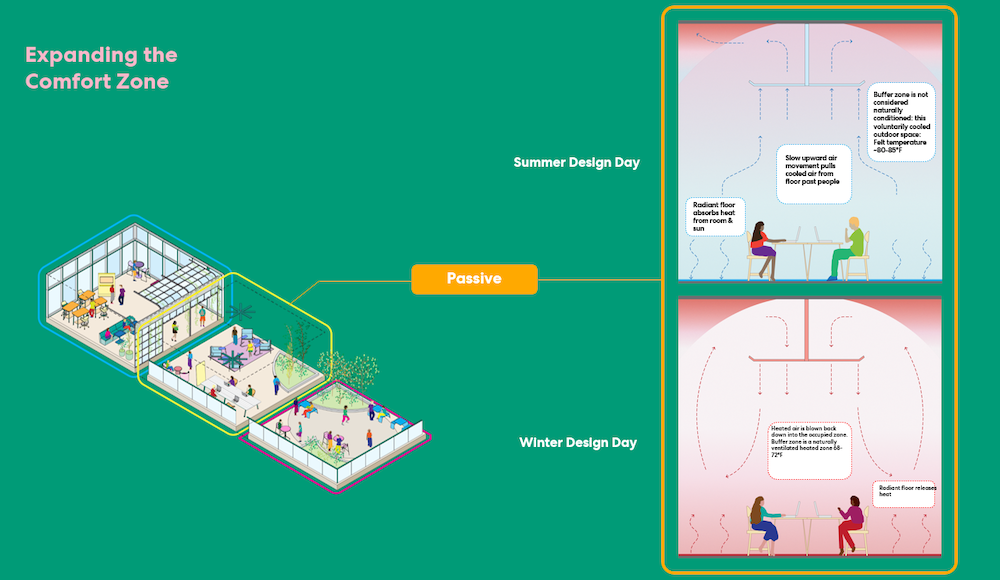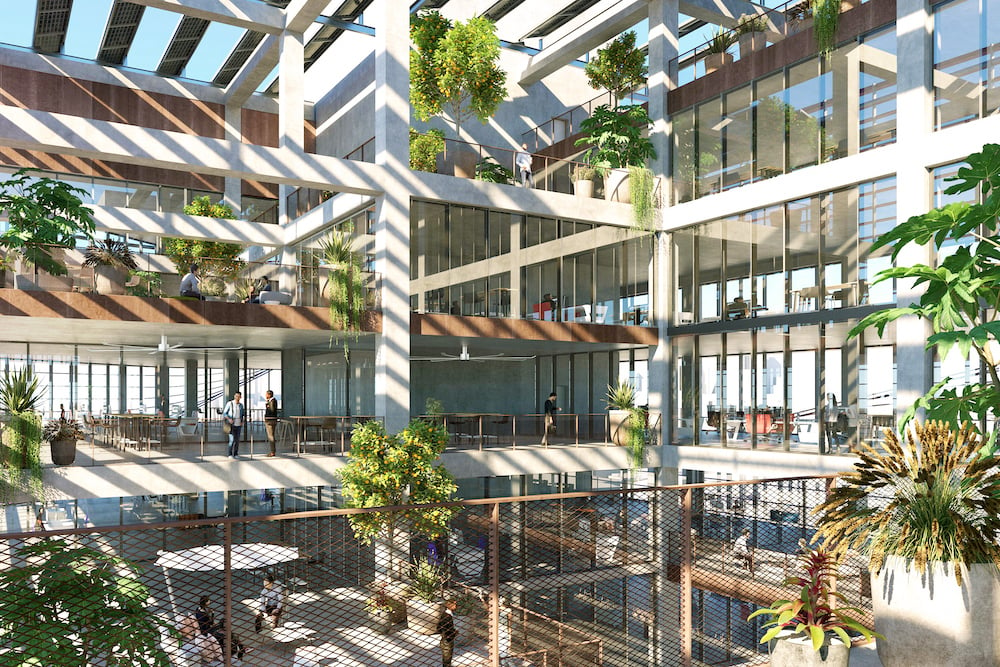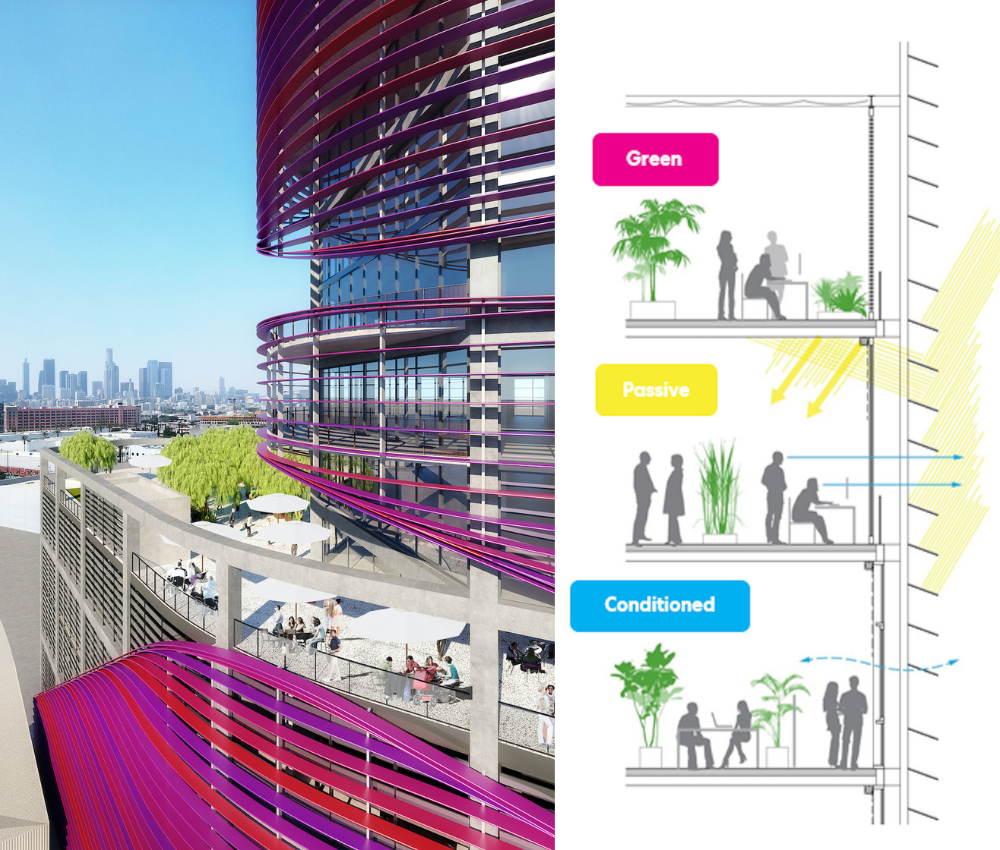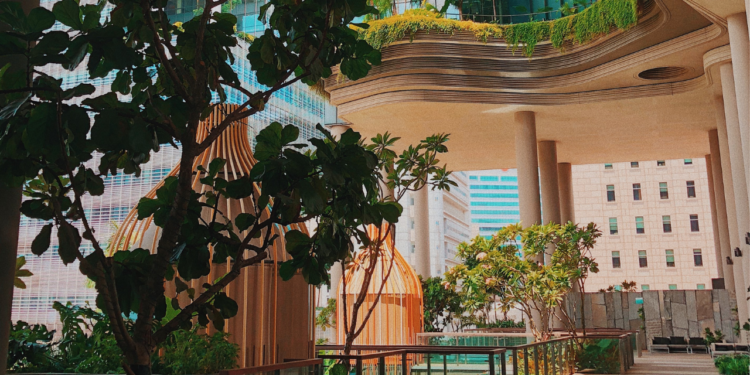- Incorporating biophilic design principles into workplace environments can have far-reaching benefits, both for individuals and for the planet.
- As designers recognize the symbiosis between sustainability and human well-being, they can create spaces that accommodate the diverse needs and preferences of different individuals.
- Providing a range of spatial, thermal, formal, and acoustical environments that prioritize health and well-being can make a workplace more attractive, making it commute-worthy.
This article was originally written by Perkins&Will’s Leigh Christy for Work Design Magazine.
Sustainable practices and well-being in design are more connected than we often treat them. A workplace design approach that engages sustainability and well-being as interconnected and complementary offers more opportunities for innovation, substituting a piecemeal, a-la-carte mindset, with a holistic attitude toward the role of design in elevating the quality of life for both people and the planet.
The pandemic helped to solidify remote work habits that had already begun to take shape due to advancing technologies and a growing demand for work/life balance. Flexibility has become the motto. But how do we understand the notion of flexibility in the context of sustainability and well-being? When it comes to flexibility, it’s about more than column free floor plates and mobile furniture systems. It is more than spatial reconfigurability.

Autonomy and Choice
From an individual human perspective, flexibility is ultimately about choice, about autonomy, about the agency the individual has—yes, to modify—but also, to have the mobility to move to new environments in a manner that suits their occupational preferences, physical comfort, and task requirements. In our evolving work culture, we understand that the traditional office is merely one locus of engagement in a larger work ecosystem. Our connectivity to work now happens in the home, in the car, at the café, on the patio, even at the park, or on an extended stay abroad.
In our burgeoning virtual landscape, embracing the physical, analog space around us is more important than ever. In this sense, claiming personal agency not only allows each of us to create more nimble and optimal working conditions but also scratches that very human itch of being present in the space we inhabit.
Specifically, providing a range of spatial, thermal, formal, and acoustical environments that prioritize health and well-being can make a workplace more attractive, making it commute-worthy. Creating a network of usable outdoor spaces that are hyper specific to surrounding microclimates can introduce novel ways of working in the workplace that cannot be replicated at home or in traditional office buildings. Consider the direct connections to the static nature of a potted plant or the dynamic nature of a light breeze which have been shown to increase focus as well as provide overall cognitive benefits to the humans experiencing them.

Outdoor space as workspace
At the Arts District project, a design concept under entitlement in Los Angeles, approximately 20 percent of the regularly programmed, fully leasable office areas are located outside, with sliding indoor/outdoor connection. The design takes full advantage of the Southern California climate, where it is sunny 75 percent of the year with an average of 72 degrees Fahrenheit.
For these office areas, we employ three biophilic “building blocks:” the green office, open or partially shaded outdoor areas with vegetation; the passive office, covered outdoor areas, with large controllable openings to the interior; and the conditioned office, high efficiency conditioned interior space.

Each block is seamlessly connected to the other, giving building users more than just a nook in the corner, but whole environments that they can venture to depending on their preferences throughout a given day. This integrated approach creates seamless connections between meeting spaces and amenities so employees can choose where and how to work.

Leveraging the indoor/outdoor dynamic
A distinct quality of Los Angeles’ Arts District is its abundance of warehouse-style roll-up doors that give pedestrians a glimpse into the shops and artist studios. The Arts District concept embraces this “open door” concept in its upper levels, allowing tenants in the conditioned offices to connect to the outside while selectively showcasing work in progress, tying the spatial qualities of the office to its neighborhood, and expanding the spatial area for effective passive ventilation.
The passive office is furnished similarly to the conditioned office but uses the thermal mass of the concrete floor to absorb summer heat. Fans pull the cooled air upward past occupants. In the winter, the radiant floor releases heat and the fans blow the heated air back down towards occupants. At the exterior, louvers circle the building and are optimized in location, sizing, and spacing to mitigate extreme environmental conditions while maintaining views.

In the outdoor green offices, plugs and IT access remain present with more casual seating. A courtyard is shaded by a photovoltaic array that provides approximately 20% of building energy while shading much of the green office spaces. Movable shades and misters can be used in the summer. In the winter, hats, scarves, and puffer jackets are once again essential fashion accessories in the biophilic workplace.
The design strategies that compose these biophilic building blocks have the potential to decrease operational energy loads of the building. On the Arts District Concept, initial analyses have forecasted up to 10% EUI reduction based solely on lowered energy loads on the HVAC system. Moreover, the photovoltaic array creates shade while also supporting the long-term resilience of the building as Southern California shifts from gas to electric and grapples with the increased demand for EV charging, and continues system-wide distribution upgrades.
Incorporating biophilic design principles into workplace environments can have far-reaching benefits, both for individuals and for the planet. You don’t have to be working in Los Angeles to see those benefits. Every locality has its own microclimate and work culture. The biophilic workplace components remain the same, but the proportion of use can be calibrated to the local conditions in question. The details of their execution can be tweaked as well.
As we recognize the symbiosis between sustainability and human well-being, we can create spaces that accommodate the diverse needs and preferences of different individuals. It’s not just about taking breaks. It’s about breaking free to get outside for work itself. This approach responds to the modern workplace, where remote work and flexible schedules have become more common, and it addresses the environmental need for decreased carbon loads.
By leveraging the natural tendencies and habits that have emerged in this age of mobility, we can craft work environments that are more inclusive, adaptable, and responsive to the needs of the humans who use them.


 Dr. Gleb Tsipursky – The Office Whisperer
Dr. Gleb Tsipursky – The Office Whisperer Nirit Cohen – WorkFutures
Nirit Cohen – WorkFutures Angela Howard – Culture Expert
Angela Howard – Culture Expert Drew Jones – Design & Innovation
Drew Jones – Design & Innovation Jonathan Price – CRE & Flex Expert
Jonathan Price – CRE & Flex Expert














